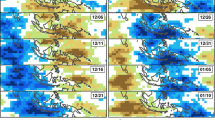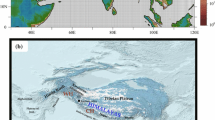Abstract
This study identifies favorable synoptic backgrounds for indirect precipitation events over the Korean Peninsula that occur well in advance of tropical cyclone (TC) landfall. Two TCs, i.e., Rammasun (2002) and Maemi (2003) that made landfall and produced heavy rainfall over the Peninsula are compared. Although both had a remarkably similar accumulated rainfall pattern over the peninsula, the temporal evolutions of hourly rainfall were different. Only Maemi had an indirect precipitation event in conjunction with a midlatitude trough to its north. The confluent flows at middle-to-upper levels were strengthened due to the increased pressure gradient between the midlatitude trough and the subtropical high, and the warm advection by the confluent flows also became stronger near the confluent zone. By contrast, Rammasun encountered the subtropical ridge while moving northward, which results in slow recurvature and reduction of the thermal gradient over the peninsula. The highly baroclinic synoptic backgrounds in the Maemi case lead to the midlevel frontogenesis. Budget analyses using the three-dimensional frontogenesis equation revealed that the horizontal deformation forcing had a primary role in generating the front. The front was associated with a thermally direct circulation that contributed to strong ascent and indirect precipitation over the peninsula well in advance of the landfall of Maemi. Moreover, the indirect precipitation could intensify due to the abundant low-level moisture supply to the frontal zone by the southerly wind on the east side of the TC.
Similar content being viewed by others
References
Agustí-Panareda, A., C. D. Thorncroft, G. C. Craig, and S. L. Gray, 2004: The extratropical transition of Hurricane Irene (1999): A potential vorticity perspective. Quart. J. Roy. Meteor. Soc., 130, 1047–1074.
____, S. L. Gray, G. C. Craig, and C. D. Thorncroft, 2005: The extratropical transition of Tropical Cyclone Lili (1996) and its crucial contribution to a moderate extratropical development. Mon. Wea. Rev., 133, 1562–1573.
Atallah, E. H., L. F. Bosart, and A. R. Aiyyer, 2007: Precipitation distribution associated with landfalling tropical cyclones over the eastern United States. Mon. Wea. Rev., 135, 2185–2206.
Baek, E.-H., G.-H. Lim, J.-H. Kim, and J.-S. Kug, 2013: Mid-tropospheric frontogenesis caused by the interaction between a typhoon and midlatitude trough: A case study of Typhoon Rusa (2002). J. Geophys. Res, submitted.
Ballentine, R. J., 1980: A numerical investigation of New England coastal frontogenesis. Mon. Wea. Rev., 108, 1479–1497.
Bryan, G. H., and J. M. Fritsch, 2000: Diabatically driven discrete propagation of surface fronts: A numerical analysis. J. Atmos. Sci., 57, 2061–2079.
Bluestein, H. B., 1993: Synoptic-Dynamic Meteorology in Midlatitudes, vol. 2, Observations and Theory of Weather Systems. Oxford Univ. Press, New York, 253 pp.
Burpee, R. W., and M. L. Black, 1989: Temperal and spatial variations of rainfall near the centers of two tropical cyclones. Mon. Wea. Rev., 117, 2204–2218.
Byun, K. -Y., and T. -Y. Lee, 2012: Remote effects of tropical cyclones on heavy rainfall over the Korean peninsula — statistical and composite analysis. Tellus, 64, 14983, doi: 10.3402/tellusa.v64i0.14983.
Chen, L., Y. Li, and Z. Cheng, 2010: An overview of research and forecasting on rainfall associated with landfalling tropical cyclones. Adv. Atmos. Sci., 27(5), 967–976.
Chien, F.-C., and H.-C. Kuo, 2011: On the extreme rainfall of Typhoon Morakot (2009). J. Geophys. Res., 116, D05104, doi:10.1029/2010-JD015092.
Cordeira, Jason M., Lance F. Bosart, 2011: Cyclone interactions and evolutions during the “Perfect Storms” of late October and early November 1991. Mon. Wea. Rev., 139, 1683–1707.
Doswell, C. A., III, H. E. Brooks, and R. A. Maddox, 1996: Flash flood forecasting: An ingredients-based methodology. Wea. Forecasting, 11, 560–581.
Galarneau, T. J., Jr., L. F. Bosart, C. A. Davis, and R. McTaggart-Cowan, 2009: Baroclinic transition of a long-lived mesoscale convective vortex. Mon. Wea. Rev., 137, 562–584.
____, _____, and R. S. Schumacher 2010: Predecessor rain events ahead of tropical cyclones. Mon. Wea. Rev., 138, 3272–3297.
Harr, P. A., and R. L. Elsberry, 2000: Extratropical transition of tropical cyclones over the western North Pacific. Part I: Evolution of structural characteristics during the transition process. Mon. Wea. Rev., 128, 2613–2633.
Hart, R. E., J. L. Evans, and C. Evans, 2006: Synoptic conditions of the extratropical transition life cycle of North Atlantic tropical cyclones: Factors determining posttransition evolution. Mon. Wea. Rev., 134, 553–578.
Kitabatake, N., 2001: Extratropical transformation of Typhoon Vicki (9807): Structural change and the role of upper-tropospheric disturbances. J. Meteor. Soc. Japan, 80, 229–247.
Koch, S. E., J. T. McQueen, and V. M. Karyampudi, 1995: A numerical study of the effects of differential cloud cover on cold frontal structure and dynamics. J. Atmos. Sci., 52, 937–964.
Lee, D.-K., and S.-J. Choi, 2010: Observation and numerical prediction of torrential rainfall over Korea caused by Typhoon Rusa (2002). J. Geophys. Res., 115, D12105, doi:10.1029/2009JD012581.
Lin, Y. L., D. B. Ensley, S. Chiao, and C.-Y. Huang, 2002: Orographic influences on rainfall and track deflection associated with the passage of a tropical cyclone. Mon. Wea. Rev., 130, 2929–2950.
Locatelli, J. D., M. T. Stoelinga, and P. V. Hobbs, 2002: Organization and structure of clouds and precipitation on the mid-Atlantic coast of the United States. Part VII: Diagnosis of a nonconvective rainband associated with a cold front aloft. Mon. Wea. Rev., 130, 278–297.
Marks, F. D., Jr., 1985: Evolution of the structure of precipitation in Hurricane Allen (1980). Mon. Wea. Rev., 113, 909–930.
Martin, J. E., J. D. Locatelli, and P. V. Hobbs, 1992: Organization and structure of clouds and precipitation on the mid-Atlantic coast of the United States, Part V: The role of an upper-level front in the generation of a rainband, J. Atmos. Sci., 49, 1293–1303.
Merrill, J. T., R. Bleck, and D. Boudra, 1986: Techniques of Lagrangian trajectory analysis in isentropic coordinates. Mon. Wea. Rev., 114, 571–581.
Moore, Richard W., Michael T. Montgomery, 2005: Analysis of an idealized, three-dimensional diabatic Rossby vortex: A coherent structure of the moist baroclinic atmosphere. J. Atmos. Sci., 62, 2703–2725.
Novak, David R., Lance F. Bosart, Daniel Keyser, Jeff S. Waldstreicher, 2004: An observational study of cold season-banded precipitation in Northeast U.S. cyclones. Wea. Forecasting, 19, 993–1010.
Orlanski, I., B. Ross, L. Polinsky, and R. Shaginaw, 1985: Advances in the theory of atmospheric fronts. Advances in Geophysics, Academic Press, 223–252.
Park, S. K., and E. Lee, 2007: Synoptic features of orographically enhanced heavy rainfall on the east coast of Korea associated with Typhoon Rusa (2002). Geophys. Res. Lett., 34, L02803, doi:10.1029/2006GL028592.
Shimazu, Y., 1998: Classification of precipitation systems in mature and early weakening stages of typhoons around Japan. J. Meteor. Soc. Japan, 76, 437–445.
Schumacher, R. S., T. J. Galarneau Jr., and L. F. Bosart, 2011: Distant effects of a recurving tropical cyclone on rainfall in a midlatitude convective system: A high-impact predecessor rain event. Mon. Wea. Rev., 139, 650–667.
Wang, Y., Y. Wang, and H. Fudeyasu, 2009: The role of Typhoon Songda (2004) in producing distantly located heavy rainfall in Japan. Mon. Wea. Rev., 137, 3699–3716.
Wu, C.-C., 2001: Numerical simulation of Typhoon Gladys (1994) and its interaction with Taiwan terrain using the GFDL hurricane model. Mon. Wea. Rev., 129, 1533–1549.
____, T.-H. Yen, Y.-H. Kuo, and W. Wang, 2002: Rainfall simulation associated with Typhoon Herb (1996) near Taiwan. Part I: The topographic effect. Wea. Forecasting, 17, 1001–1015.
____, K. K. W. Cheung, and Y.-Y. Lo, 2009: Numerical study of the rainfall event due to the interaction of Typhoon Babs (1998) and the northeasterly monsoon. Mon. Wea. Rev., 137, 2049–2064.
Author information
Authors and Affiliations
Corresponding author
Rights and permissions
About this article
Cite this article
Baek, EH., Kim, JH., Kug, JS. et al. Favorable versus unfavorable synoptic backgrounds for indirect precipitation events ahead of tropical cyclones approaching the Korean Peninsula: A comparison of two cases. Asia-Pacific J Atmos Sci 49, 333–346 (2013). https://doi.org/10.1007/s13143-013-0032-z
Received:
Revised:
Accepted:
Published:
Issue Date:
DOI: https://doi.org/10.1007/s13143-013-0032-z




